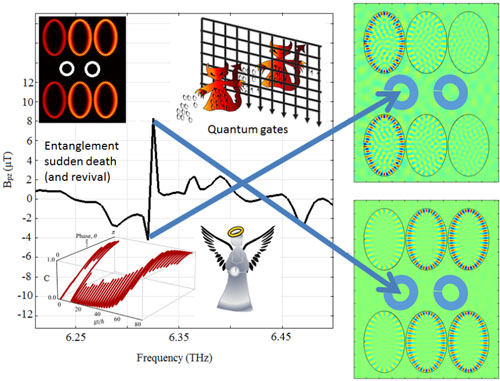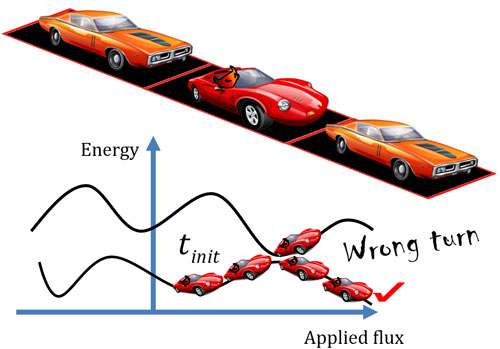| Posted: May 10, 2016 | |
Whispering gallery modes to control artificial atoms for quantum computing |
|
| (Nanowerk Spotlight) Nanostructures with superconducting electrons are highly intriguing artificial systems that in many ways mimic naturally occurring atoms. One potential use of these artificial atoms is to implement quantum bits (qubits in short) – the basic units of quantum information in quantum computing. | |
| An important aspect of quantum technology development is to maintain the coherence between qubits with a super correlation between them – so-called entanglement. Wave-qubit hybrids are a novel type of a hybrid quantum system that can be used to produce quantum gates (such as a phase gate) and that are essential for quantum logic operations. It is possible that this new architecture can be scaled to produce much larger networks, which essentially will consist of multiple groups of resonators with embedded qubits and therefore will operate without adverse background noise that destroys the quantum state. | |
| "Quantum computation using artificial atoms can be sensitively controlled by external electromagnetic fields," Dr. Michael Forrester, a Research Associate in the Chemical Engineering department at Loughborough University, explains to Nanowerk. "These fields and the self-fields attributable to the coupled artificial atoms influence the amount of quantum correlation in the system. However, control elements that can operate without complete destruction of the entanglement of the quantum bits are difficult to engineer." | |
| In new work, Forrester, together with his colleague Feodor Kusmartsev, have investigated the possibility of using closely spaced linear arrays of metallic elliptical discs as whispering gallery waveguides to control artificial atoms. | |
| They report their findings in the April 28, 2016 online edition of Scientific Reports ("Whispering galleries and the control of artificial atoms"). | |
| "Here, for the first time, we have demonstrated a new noninvasive method for quantum computing and quantum control," Forrester and Kusmartsev point out. "The method is contactless and uses the resonant modes of the cavity with embedded qubits. This discovery opens the possibility of wave-qubit hybrids of quantum technologies for quantum information processing, which can be realized in many ways." | |
 |
|
| Figure 1: The control of quantum devices/artificial atoms, such as π-rings, by whispering mode arrays. (Image: Michael Forrester) (click on image to enlarge) | |
| The scientists used metallic disks with engineered defects to control qubits of a special type, in the form of superconducting loop called a π-ring that can generate its own spontaneous supercurrent. | |
| The topology and components of the setup makes it an electronically isolated system, i.e. it has a minimalistic requirement for electronic circuitry – all the control and computing is via propagating or exciting waves. It operates preferentially at terahertz frequencies with 'whispering gallery' modes controlling the artificial atoms (the π-rings). | |
| In their work, the two scientists solve the quantum wave equations – Schrödinger equations – including an energy equation that describes the magnetic fields generated by the whispering gallery array, the qubits, and their interaction. | |
| This simple approach is also supported by a density matrix analysis that describes the temperature sensitivity of the entanglement. | |
| "We find that the entanglement undergoes complete breakdown, followed by revivals – entanglement sudden death," says Forrester. | |
 |
|
| Figure 2: Another possibility for the wave-qubit hybrid system is adiabatic quantum computation. Using the Lloyd analogy between adiabatic computation and parking a car: the vehicle can only manoeuvre slowly, backwards and forwards into a space between two other vehicles - adiabatic quantum computation also has to be a slow evolution. Starting at some initial time the system is prepared into its lowest energy configuration and evolves as a function of the applied magnetic flux. The energy landscape has to be suitably chosen as too fast an evolution and a jump into an unwanted energy level is made (a wrong turn). (Image: Michael Forrester) | |
| This new system is one of 'silent' qubits (flux qubits) that function without unfavorable noise. The only minimal requirement for such quantum technology is the quality factor of resonators, which are embedding the qubits and controlling them via whispering galleries. | |
| This approach is a completely new integration of quantum technologies that is motivated by the requirement for functional quantum logic systems using quantum gates. | |
| Alternative methods, such as quantum annealing and adiabatic quantum computing have reached the market (D-Wave Systems), whereas the flux qubit types of quantum logic, based on quantum gates, has been hindered by decoherence. | |
| The control elements in current quantum technologies, such as those of D-Wave, are based on building direct electronic circuits. Because of that, it becomes impossible to create specific quantum gates with large numbers of qubits due to an increase of the noise and loss of the qubits' coherence when the size of the system increases. | |
| The solution found by D-Wave Systems is adiabatic quantum computing that is related to an evolution of the ground state and produces only one type of operation. | |
| "The finding of our paper also shows a way how the present adiabatic quantum computing technology can be significantly improved," notes Forrester. | |
| He adds that it should be relatively simple to demonstrate coupled qubit effects with control elements that make use of plasmonics and whispering galleries. Once scalable, it is possible to solve quantum algorithms and problems such as finding the optimal molecular sequencing for drug development. | |
| Another application is a quantum search engine which can replace Google type searches, where the information will be transferred via whispering galleries. This is especially important since the size of the Web is growing with accelerated speed. | |
| Going forward, the scientists plan to further investigate electromagnetic confinement effects in order to maximize qubit-system coupling. Another interesting way is to show that similar quantum architecture and quantum circuitry can be realized with visible light. In this case, the size of the system will be smaller and novel optoelectronic quantum computing devices can be developed. | |
| "The development of enabling technologies that allow large numbers of quantum bits to operate together in a truly quantum way, which cannot be achieved using classical physics, is on the horizon," Forrester concludes. "In this regard, the challenge is to find new ways of overcoming fabrication, noise and material issues – perhaps our current work is one such way." | |
 By
Michael
Berger
– Michael is author of three books by the Royal Society of Chemistry:
Nano-Society: Pushing the Boundaries of Technology,
Nanotechnology: The Future is Tiny, and
Nanoengineering: The Skills and Tools Making Technology Invisible
Copyright ©
Nanowerk LLC
By
Michael
Berger
– Michael is author of three books by the Royal Society of Chemistry:
Nano-Society: Pushing the Boundaries of Technology,
Nanotechnology: The Future is Tiny, and
Nanoengineering: The Skills and Tools Making Technology Invisible
Copyright ©
Nanowerk LLC
|
|
|
Become a Spotlight guest author! Join our large and growing group of guest contributors. Have you just published a scientific paper or have other exciting developments to share with the nanotechnology community? Here is how to publish on nanowerk.com. |
|
